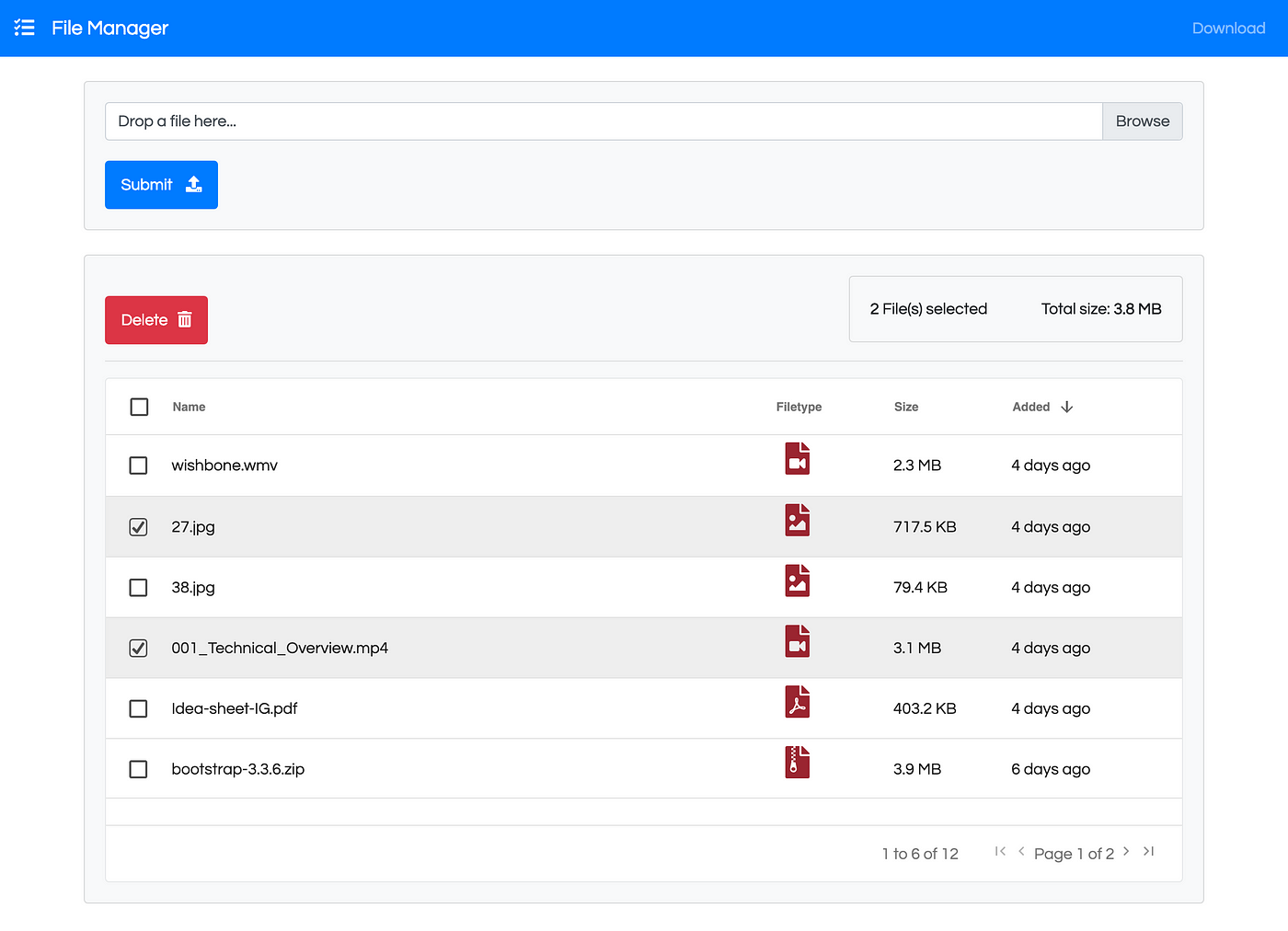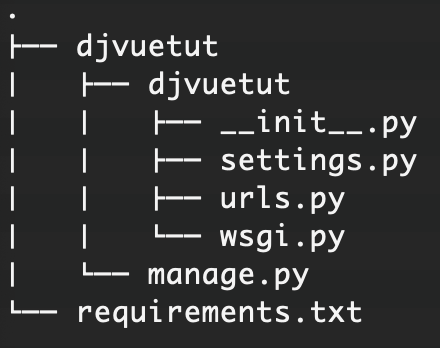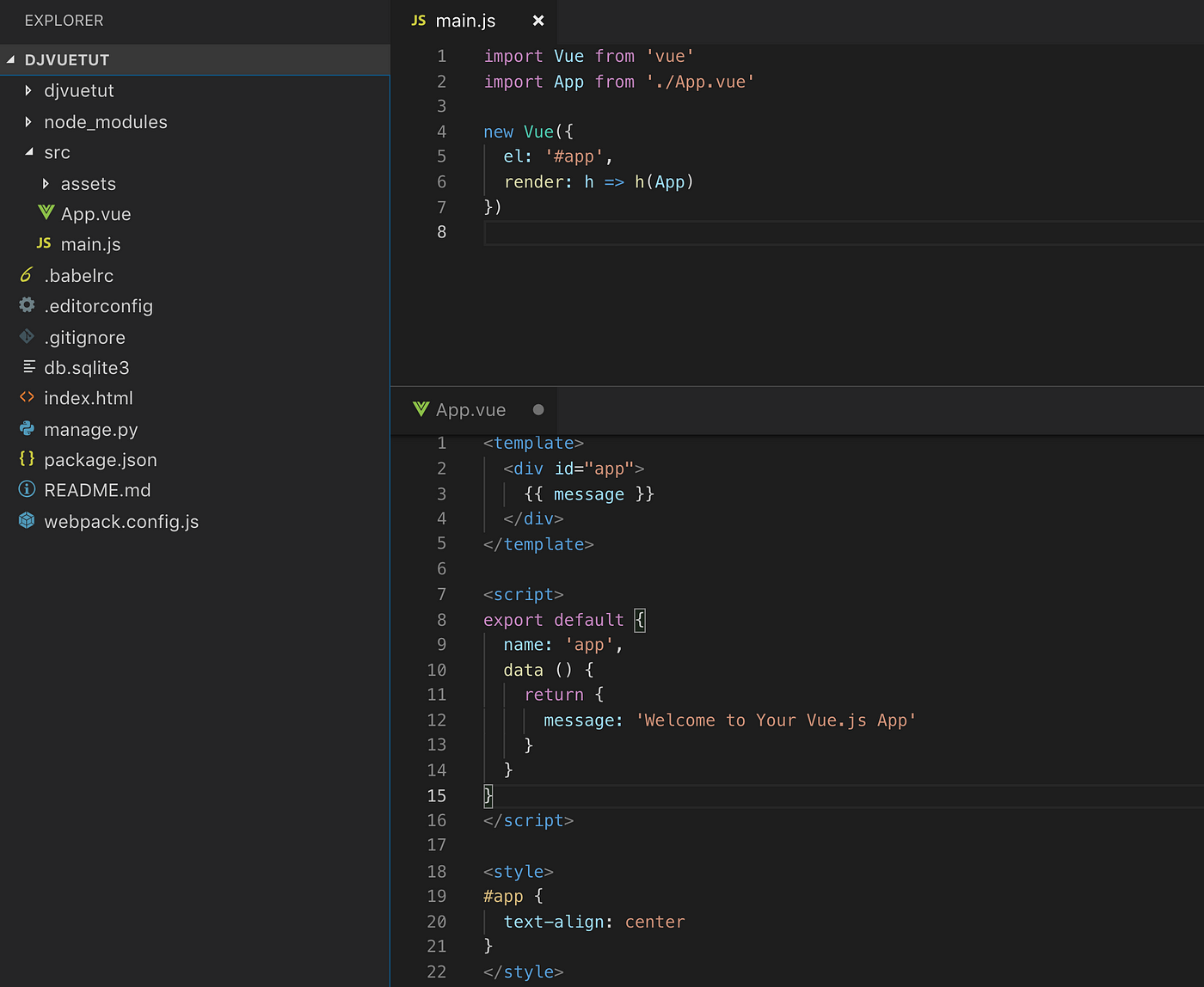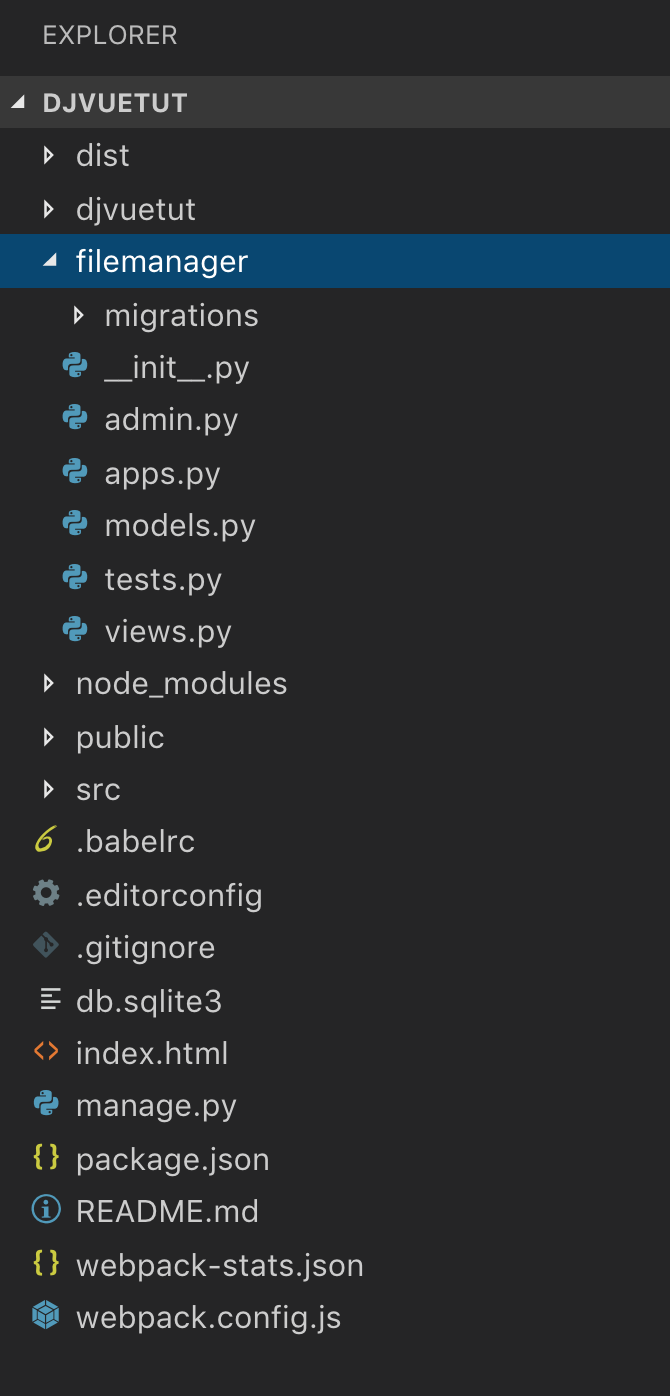Vue and Image Upload to Django Rest
Part one — How to build a File Manager Storage web app with Django Rest Framework and Vue.js with Vuex and Ag-grid integration

Since commencement of this year, I have been attention an online course. We have a platform that enables us to store and share files collaboratively. I wanted to clone it, so this web application thought was born ✍️
I will guide yous step past footstep to create a File Manager storage spider web application. we volition have a tech stack as Django with DRF, vue.js with webpack and vuex and libraries such as ag-filigree, bootstrap, axios etc. 🎬
I broke upwardly this tutorial into two parts. Function one focuses on setting upwards Django with DRF and Vue.js and making configurations and preparing our Residuum API in backend. Part 2 goes over frontend and finishing our application with vue.js, vuex and ag-grid. If you lot desire to take a look at part 2 earlier diving in, follow the link below:
In the first role of this tutorial we are going to:
- Install and setup Django with Django Rest Framework
- Install Vue.js and webpack
- Configure Django and vue to make them work together
- Create a database model in Django
- Create an API endpoint with Django Rest Framework
Let's showtime coding! I suppose that you lot have Python 3.half dozen+ and Node.js installed.
Nosotros beginning with creating a new environment every bit following. We are going to apply "virtualenv" module which comes with Pythton 3.6
(OSX)
python3 -yard venv .env (Linux and Windows)
virtualenv .env # Activate your environment
. .env/bin/activate
We are going to use:
Django — Vue.js 2.0 — Webpack
Information technology is good practice to create and requirements.txt file to install our dependencies for Django.
cat > requirements.txt
Django
django-rest-framework
django-webpack-loader Press Command + D to relieve the file or install each library with pip manually.
Enter the following and run requirements.txt to install Django and DRF, also with webpack loader package which we will need to make django to talk to vue.
pip3 install -r requirements.txt Side by side, create a Django projection
django-admin startproject djvuetut 
Your current file tree should look like this for the moment. You may want to test it and see that it runs in your browser.
cd djvuetut
python manage.py runserver # commencement your server in localhost:8000 Ignore any unapplied migrations alarm for the moment and permit's check http://localhost:8000 and make certain you take a running django app!
click control + C to stop the server.
Now, we will go along with Vue.js installation and setup.
~ brand sure that you are in the same directory with manage.py
enter the commands below to install vue-cli and webpack with simle configuration.
npm install -g vue-cli
vue init webpack-simple Generate project in current directory? Yes
Project name djvuetut
Project description A Vue.js project
Author talented <ozguryarikkas@gmail.com>
License MIT
Utilize sass? No vue-cli · Generated "djvuetut". To become started:npm install
npm run dev
as stated:
enter npm install to install dependencies (npm modules) — This may take a while and npm run dev to start the server:
npm install
npm run dev Default server port for Vue.js is 8080 so y'all can test that it runs at http://localhost:8080 if it doesn't load automatically.

But a quick introduction on how Vue is working in principal:
→ a vue.js instance is already created in principal.js
→ the property el: binds the Vue case to the HTML element with id="app" and tell u.s.a. that information technology is rendered in App.vue
→ in App.vue we have the Vue.js system to enable u.s.a. to render information into DOM using double braces syntax.
Configure Django and Vue to work together
At present nosotros need some Vue.js plugins to integrate vue with django. We already installed django-webpack-loader packet for django. It requires just a few settings to piece of work. Starting time we need to install the following plugin.
Install the following by using npm
npm install --save-dev webpack-bundle-tracker
npm install --relieve-dev write-file-webpack-plugin after installing these packages, it is time to brand some configurations. Make the following changes in webpack.config.js
# ./webpack.config.js var path = require('path');
var webpack = require('webpack');
var BundleTracker = require('webpack-packet-tracker'); // add this module.exports = {
entry: './src/chief.js',
output: {
path: path.resolve(__dirname, './dist'),
// publicPath is deleted here
filename: 'build.js'
},
plugins: [ // add this new BundleTracker({ // add this filename: './webpack-stats.json' // add together this
}) // add this
], // add this module: {
rules: [
....
in django settings, add the post-obit:
# ./djvuetut/settings.py # add 'webpack_loder' to INSTALLED APPS INSTALLED_APPS = [
'django.contrib.admin',
'django.contrib.auth',
'django.contrib.contenttypes',
'django.contrib.sessions',
'django.contrib.messages',
'django.contrib.staticfiles',
'webpack_loader', # add this
] ... # Configure TEMPLATES DIRS and add BASE_DIR TEMPLATES = [
{
'BACKEND': 'django.template.backends.django.DjangoTemplates',
'DIRS': [BASE_DIR], # update here
'APP_DIRS': True,
'OPTIONS': {
'context_processors': [
'django.template.context_processors.debug',
'django.template.context_processors.asking',
'django.contrib.auth.context_processors.auth', 'django.contrib.messages.context_processors.messages',
],
},
},
] # Add this to the end of settings # settings for django-webpack-loader
STATIC_ROOT = os.path.join(BASE_DIR, 'public')
STATICFILES_DIRS = (
os.path.join(BASE_DIR, 'dist'),
)
WEBPACK_LOADER = {
'DEFAULT': {
'Cache': not DEBUG,
'BUNDLE_DIR_NAME': '',
'STATS_FILE': os.path.join(BASE_DIR, 'webpack-stats.json'),
'POLL_INTERVAL': 0.1,
'TIMEOUT': None,
'IGNORE': ['.+\\.hot-update.js', '.+\\.map']
}
}
Aye, now we are ready with our configuration. We will need to add together our django tags to the chief alphabetize.html to load the render-bundle from webpack-bundle. final wait of index.html will look like beneath with added tags:
# ./alphabetize.html <!DOCTYPE html>
<html lang="en">
<head>
<meta charset="utf-8">
<title>djvuetut</championship>
</head>
<trunk>
{% load render_bundle from webpack_loader %} // add together this <div id="app">
<django></django> // add this
</div> {% render_bundle 'main' %} // add this
</body>
</html>
We also need to update the urls.py in djvuetut binder every bit follows:
# .djvuetut/urls.py from django.conf.urls import url
from django.contrib import admin
from django.views.generic import TemplateView urlpatterns = [
path('admin/', admin.site.urls),
path('', TemplateView.as_view(template_name='alphabetize.html'), name='Dwelling house'),
]
and nosotros need to add <django> tag as a component to our Vue instance in main.js under /src
# ./src/main.js import Vue from 'vue'
import App from './App.vue' new Vue({
el: '#app',
components: {
'django': App // add together this
}
})
nosotros should be ready now. Run the latest commands beneath.
# Compile VueJS App
npm run build #collect static files in public binder
python manage.py collectstatic #start django server in localhost
python manage.py runserver
Voila! 👏👏👏 when you road to http://localhost:8000 , you should exist seeing your view in App.vue. Now you take a fully working vue.js app with a django backend.
Create an API endpoint with Django rest framework
the goal is to create and API endpoint to:
- upload and download files to the server
- brandish a list of files in our database
permit's start an django app and call it filemanager, and so we create our models for our API
django-admin startapp filemanager we need to add it under INSTALLED_APPS in settings.py
we have already installed DRF when we run our requirements.txt but we also demand to add together it to installed apps to let django know that we are going to use it.
# ./djvuetut/settings.py INSTALLED_APPS = [
...
'webpack_loader',
'filemanager' # add this
'rest_framework', # add this ]
actual file tree should look like this:

nosotros will also create an admin user to manage our database from admin portal provided by django admin in case we demand information technology. But first we have to migrate any changes earlier creating a super user:
$ python manage.py migrate
$ python manage.py createsuperuser # I think creating a super user is self explanatory. We will use information technology later.
What we have to practice now:
- Create our model and fields to store file data in database
- Create a folder in base project directory to store MEDIA data
- Add together media related settings (MEDIA_ROOT & MEDIA_URL) to settings.py
- Modify url.py to handle static media content
allow'south start with creating a model for our file manager in models.py:
# ./filemanager/models.py from django.db import models
from django.utils import timezone class Data(models.Model):
file_id = models.AutoField(primary_key=True)
file = models.FileField(null=True, max_length=255)
date_created = models.DateTimeField(default = timezone.now) def __str__(self):
return str(cocky.file.proper name)
our model enables usa to upload any file with any extension and size. We oasis't setup whatsoever validators still, we will make the fine tuning later. We need to complete a few more configuration to make it work.
# ./djvuetut/settings.py MEDIA_URL = "/media/" # add together this
MEDIA_ROOT = bone.path.join(BASE_DIR, 'media') # add this
we also need to configure our urls.py and define the new added folder as a static binder.
# ./djvuetut/urls.py ...
from django.conf import settings # add together this from django.conf.urls.static import static # add together this urlpatterns = [
...
] if settings.DEBUG:
urlpatterns += static( # add this
settings.STATIC_URL,
document_root=settings.STATIC_ROOT
)
urlpatterns += static( # add this
settings.MEDIA_URL, document_root=settings.MEDIA_ROOT)
Django Rest Framework (DRF) Setup
we will define a folder called "media" to go along our files. It will be automatically created in our first upload. now, it is time to create a setup to be able to use DRF.
At that place are more than one mode and I wanted to create the most hassle free setup. It might not exist and then detailed or if we want to scale our app in the future, we may need to update our lawmaking accordingly. To maintain the correct business logic, we are going to create 3 files:
- viewsets.py
- serializers.py
- routers.py
Allow me add the required code for each. After that I will give an explanation what they do in general.
Create serializers.py under ./filemanager and add together the following code:
# ./filemanager/serializers.py from rest_framework import serializers
from .models import Data class DataSerializer(serializers.ModelSerializer): size = serializers.SerializerMethodField()
proper name = serializers.SerializerMethodField()
filetype = serializers.SerializerMethodField()
since_added = serializers.SerializerMethodField() course Meta:
model = Information
fields = ('file_id', 'file', 'since_added', 'size', 'name', 'filetype') def get_size(self, obj):
file_size = ''
if obj.file and hasattr(obj.file, 'size'):
file_size = obj.file.size
return file_size def get_name(self, obj):
file_name = ''
if obj.file and hasattr(obj.file, 'name'):
file_name = obj.file.name
return file_name def get_filetype(self, obj):
filename = obj.file.proper name
return filename.carve up('.')[-one] def get_since_added(cocky, obj):
date_added = obj.date_created
return date_added
Serializers allow complex data such every bit querysets and model instances to be converted to native Python datatypes that can then be hands rendered into JSON, XML or other content types.
The ModelSerializer class provides a shortcut that lets you automatically create a Serializer class with fields that represent to the Model fields.
We have to use also SerializerMethodField to become the attributes of our file. we tin just serialize file_name, file_size and filetype with this way. Get more than info virtually serializers hither in original documentation: http://www.django-balance-framework.org/api-guide/serializers/
create viewsets.py under ./filemanager and add together the following code:
# ./filemanager/viewsets.py from rest_framework import viewsets
from .models import Information
from .serializers import DataSerializer class DataViewSet(viewsets.ModelViewSet):
queryset = Data.objects.all()
serializer_class = DataSerializer
DRF allows yous to combine the logic for a set of related views in a single class, called a ViewSet. A ViewSet grade is simply a type of class-based View.
We have to provide a queryset and a serializer class that we already created in our serializers.py
Get more info virtually viewsets hither in original documentation: http://www.django-rest-framework.org/api-guide/viewsets/
create routers.py nether ./djvuetut and add the following code:
# ./djvuetut/routers.py from rest_framework import routers
from filemanager.viewsets import DataViewSet router = routers.DefaultRouter()
router.register(r'files', DataViewSet, base_name='data')
With this slice of lawmaking, we created a router object and annals '/files/' url extension. We desire to apply it for our API endpoint with likewise providing our viewSet.
Get more than info most routers here in original documentation: http://world wide web.django-balance-framework.org/api-guide/routers/
The important point is hither that we need to tell django'southward urls.py that we will employ a router to manage our urls with DRF
# ./djvuetut/urls.py from django.contrib import admin
from django.urls import path, include # import "include" here
from .routers import router # add this ... urlpatterns = [
path('admin/', admin.site.urls),
path('', TemplateView.as_view(template_name='index.html'),name='Dwelling house'),
path('api/', include(router.urls)), # add this
]
...
We are done for now with the DRF settings 🏹 let'due south test information technology out! 😎
Enter the following in your browser and run across what is available to us. Past the help of DRF, nosotros at present have a fully usable rest framework for our model 💪🏻
http://localhost:8000/api/ click on 'files' viewset that we defined. Here yous tin upload a file to test it out. Just cull a file and click on Mail service. You volition notice that a folder with a name "media" will be created in the root directory and the file is uploaded under it.
we will exist able to reach the properties of that file through JSON. All we need to do is to parse this JSON query in our Vue views and that's it. You lot can upload here more than 1 file and accomplish them individually by supplying their ids like that:
http://localhost:8000/api/files/<id> In the second office of this series, nosotros volition create our forepart finish in vue with bootstrap, integrate ag-grid to showcase our files, create Crud operations with axios and much more.
click hither to read Function 2 of the tutorial! ⚒⚒⚒
Source: https://medium.com/js-dojo/how-to-build-a-file-manager-storage-web-app-with-django-rest-framework-and-vue-js-e89a83318e9c
0 Response to "Vue and Image Upload to Django Rest"
Post a Comment